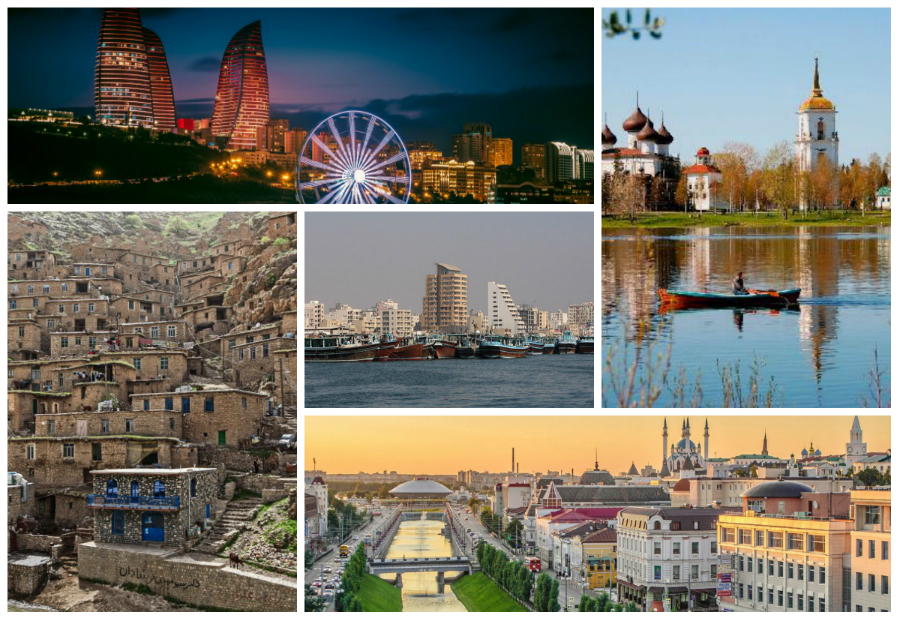Five cities from the Caspian region have been added to the United Nations Educational, Scientific and Cultural Organization (UNESCO) Creative Cities Network list based on three separate creativity nominations – design, crafts and folk art, and music.
UNESCO officials made the announcement on October 31, the day the UN recognizes as World Cities Day.
Baku, Azerbaijan’s capital city located on the western shore of the Caspian Sea, was designated as a creative city thanks to its design. The international organization also picked up Iran’s city of Sanandaj as a creative city thanks to its achievements in realms of music. The Russian city Kargopol also received recognition for crafts and folk art.
The full list of cities included 66 locales from 48 countries, including Turkey, the United Kingdom, Denmark, Chile, Australia, and others. Awards were made for several categories, including media arts, design, gastronomy, literature and film.
“All over the world, these cities, each in its way, make culture the pillar, not an accessory, of their strategy,” said Audrey Azoulay, UNESCO Director-General, according to a statement published on the organization’s website.
“This favors political and social innovation, and is particularly important for the young generations,” he added.
As the largest city on the Caspian Sea and of the Caucasus region, Baku is considered to be the scientific, cultural, and industrial center of Azerbaijan.
Baku has extremely varying architecture, ranging from the Old City core, including the Palace of the Shirvanshahs and Maiden Tower, to modern buildings and the spacious layout of Baku port. Many of the city’s most impressive buildings were built during the early 20th century, when architectural elements of the European styles were combined in eclectic style. The list of buildings that give the city a unique charm includes Heydar Aliyev Center designed by Zaha Hadid and awarded the Design Museum's Design of the Year Award, as well as Flame Towers – a trio of skyscrapers symbolizing fire.
Meanwhile, the city of Sanandaj is considered a center of Kurdish culture in Iran, while its residents are engaged in the production of traditional oriental musical instruments, especially drums. Also, Sanandaj is the core of musical production in Iran, and is home to some famous Iranian and international musicians.
Meanwhile, officials in Iran believe that the recent announcement made by UNESCO will strengthen inbound tourism.
“The fact that Sanandaj has been chosen as UNESCO’s creative city for music is one of the most important cultural events which will boost tourism,” Heshmatollah Seydi, the city’s mayor, said according to a report by IRNA.
The residents of Russian city Kargapol also believe that the city’s designation by UNESCO will attract foreigners to what is a small town in the north of the country.
Kargopol is a city founded in 1146, with a population of just over 10,000 people. It is known for the rich handicraft traditions and is home to a large state museum with extensive collections, which annually hosts many festivals of folk art, music and gastronomy. Some of them attract guests from all over Russia and from abroad.
“There are about a hundred talented craftsmen in Kargopol,” Rossiyskaya Gazeta cited the city administration’s press service as saying.
“Kargopol clay toy and pottery in general, as well as bright, meaningful holidays that contribute to the preservation and development of traditional crafts, can become effective drivers for the development of the territory.”
The Caspian cities picked up by the Creative Cities Network list also include Iran’s port city, Bandar Abbas that received recognition for crafts and folk art and Russia’s sixth most populous city, Kazan, designated as creative city thanks to its achievements in realms of music.
UNESCO launched the Creative Cities Network project in 2004, which is aimed at promoting and developing cooperation among cities by identifying creativity found within and viewing it as a major factor in their urban development.







 Armenian sappers commenced on Monday mine-clearance operations in the territories adjacent to the Saint Mary Church in village of Voskepar (Armenia...
Armenian sappers commenced on Monday mine-clearance operations in the territories adjacent to the Saint Mary Church in village of Voskepar (Armenia...
 Russian Foreign Minister Sergei Lavrov has reasserted that Moscow has no intentions to stop the fighting in Ukraine, even if peace talks commence.
Russian Foreign Minister Sergei Lavrov has reasserted that Moscow has no intentions to stop the fighting in Ukraine, even if peace talks commence.
 Iran has refuted reports of alleged damage to Shimon Peres Negev Nuclear Research Centre located southeast of Dimona, Israel, during the recent air...
Iran has refuted reports of alleged damage to Shimon Peres Negev Nuclear Research Centre located southeast of Dimona, Israel, during the recent air...
 Iran’s Foreign Minister, Hossein Amir-Abdollahian, has labeled a foiled Israeli drone attack in certain parts of the country as a "failure" for Isr...
Iran’s Foreign Minister, Hossein Amir-Abdollahian, has labeled a foiled Israeli drone attack in certain parts of the country as a "failure" for Isr...



